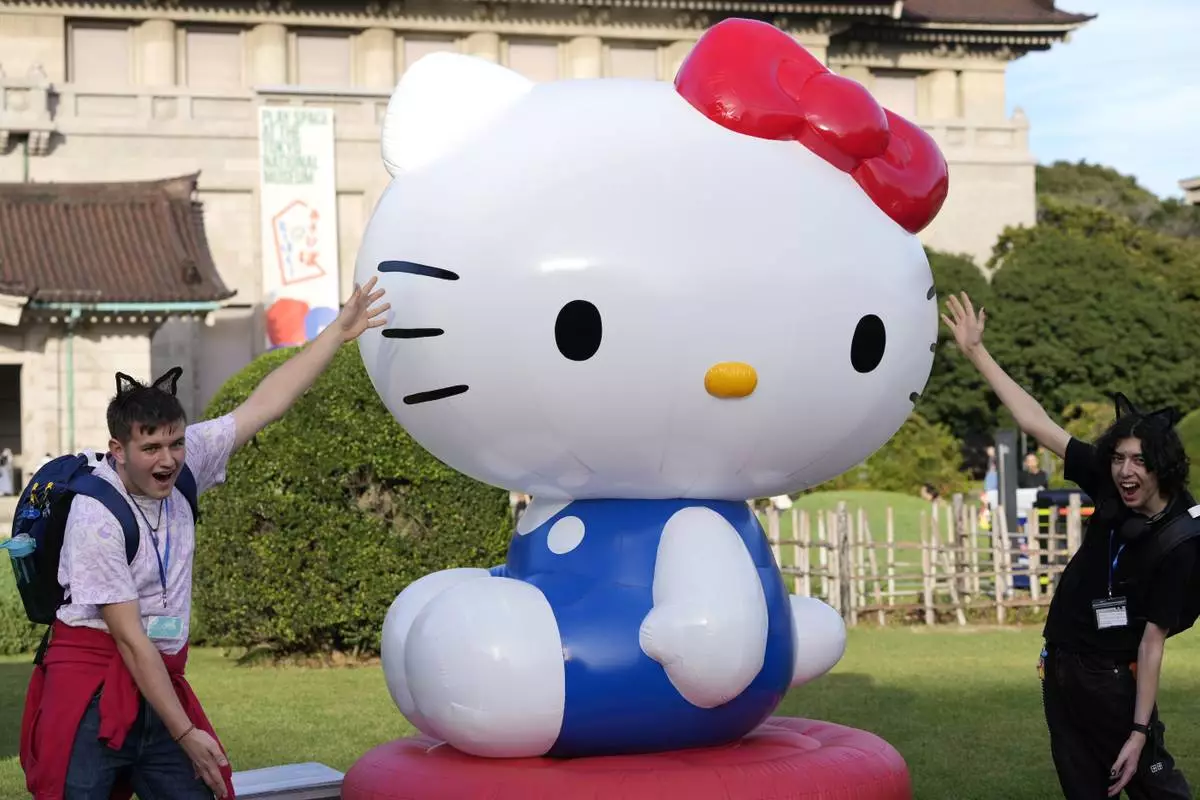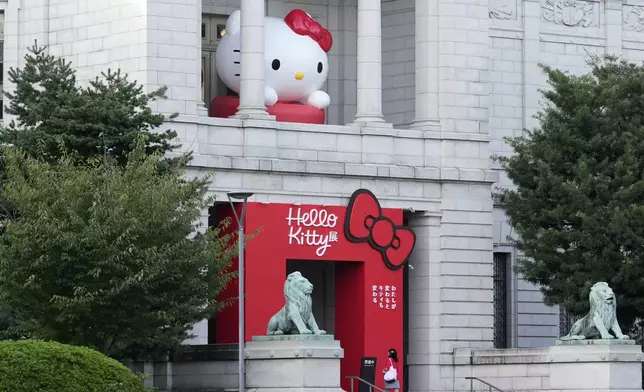TOKYO (AP) — Hello Kitty turns 50 on Friday. Befitting a pop icon at midlife, the bubble-headed, bow-wearing character's fictional birthday has brought museum exhibits, a theme park spectacle and a national tour. And that's just in Japan, her literal birthplace but not the one listed in her official biography.
Confused? Welcome to the party. If there's one thing about Hello Kitty, it's that she's proven adaptable and as much a study in contrasts during her long career. She — and Kitty is a she, according to the company that owns her — may have been conceived as a vessel for the feelings of others, but some women see an empowering symbol in her mouthless face.
“Shrewd” is how Mika Nishimura, a design professor at Tokyo’s Meisei University, describes the way Hello Kitty conquered the worlds of commerce, fashion and entertainment. As a tabula rasa open to interpretation, the non-threatening creation was the perfect vehicle for making money, she said.
“American feminists have said she doesn't say anything and acquiesces to everyone. But in Japan, we also see how she may appear happy if you're happy, and sad if you're feeling sad," Nishimura told The Associated Press. "It's a product strategy that's sheer genius. By being so adaptable, Kitty gets all those collaborative deals.”
The character's semicentennial is evidence of that. Sanrio, the Japanese entertainment company that holds the rights to Hello Kitty’s name and image, kicked off the festivities a year ago with an animation account on TikTok, Roblox games and an avatar for the social networking app Zepeto.
There have been anniversary editions of merchandise ranging from pet collars, cosmetics and McDonald's Happy Meals to Crocs and a Baccarat crystal figurine. A gold coin pendant with the image of Hello Kitty holding the number 50 is selling for about 120,000 yen ($800), while a Casio watch costs 18,700 yen ($120).
But first, more on the origin story.
Unlike Mickey Mouse and Snoopy, Hello Kitty didn’t start as a cartoon. A young Sanrio illustrator named Yuko Shimizu drew her in 1974 as a decoration for stationery, tote bags, cups and other small accessories. The design made its debut on a coin purse the next year and became an instant hit in Japan.
As Hello Kitty's commercial success expanded beyond Asia, so did her personal profile. By the late 1970s, Sanrio revealed the character's name as Kitty White, her height as five apples tall and her birthplace as suburban London, where the company said she lived with her parents and twin sister Mimmy.
“The main theme of Hello Kitty is friendship. When I first created it, I made a family of which Kitty was a part. But then Hello Kitty started to appear in other settings as the character grew,” Shimizu told the BBC in June. “Sanrio put a lot of effort into building the brand into what it is today.”
At some point, Sanrio designated Kitty's birthday as Nov. 1, the same as Shimizu's. Her background was embellished with hobbies that included playing piano, reading and baking. Her TV appearances required co-stars, including a pet cat named Charmmy Kitty that made its debut 20 years ago.
But Hello Kitty's 40th birthday brought an update that astonished fans. Sanrio clarified to a Los Angeles museum curator that Kitty, despite her feline features, was a little girl. A company spokesperson repeated the distinction this year, renewing debate online about the requirements for being considered human.
“She is supposed to be Kitty White and English. But this is part of the enigma: Who is Hello Kitty? We can't figure it out. We don't even know if she is a cat," art historian Joyce S. Cheng, a University of Oregon associate professor, said. "There is an unresolved indeterminacy about her that is so amazing.”
Part of the confusion stems from a misunderstanding of “kawaii,” which is Japanese for “cute” but also connotes a lovable or adorable essence. Sanrio recruited Shimizu and other illustrators to create “kawaii” characters at a time when cute, girlish styles were popular in Japan. But the word is used often in Japanese society, and not only to describe babies and puppies.
An elderly man, something as innocuous as an umbrella, a subcompact car or a kitchen utensil, or even a horror movie monster can get labeled “kawaii.” By Western standards, the idea may seem embarrassingly frivolous. But it’s taken seriously in Japan, where the concept is linked with the most honorable instincts.
The complexity of “kawaii” may help explain Hello Kitty's enduring appeal across generations and cultures, why Canadian singer-songwriter Avril Lavigne released a song titled “Hello Kitty” a decade ago, and why Britain's King Charles wished Hello Kitty a happy 50th birthday when he hosted Japan's Emperor Naruhito and Empress Masako at Buckingham Palace in June.
Although Hello Kitty may seem to embody the self-sacrificing woman stereotype, it’s revealing that three women have served as the character's chief designers at Sanrio. Yuko Yamaguchi, who has held the role since 1980, is credited with keeping the character both modern and timeless, giving Kitty black outfits or false eyelashes as trends dictated but never removing the bow from her left ear.
“Hello Kitty, this cultural object, has something to tell us about the history of women in East Asia, and how East Asian women modernized themselves and became professional citizens in a modern society,” the University of Oregon's Cheng said.
Sanrio has come up with hundreds of creatures, all adorable and cuddly, but none with the lasting power of Hello Kitty. Forget the understated wabi-sabi aesthetic historically associated with Japan. A chameleon-like cat-girl who reflects unabashed kitsch is the cultural ambassador of a consumer-crazed, happy-go-lucky nation.
“It’s the anti-wabi sabi, wanting to be as flashy and as bling-bling as possible, like Lady Gaga. In your face, but that’s actually part of the genius, too. It’s powerful,” Cheng said.
Leslie Bow, a professor of English and Asian American Studies at the University of Wisconsin-Madison, said that while many Asian and Asian American women see Hello Kitty as a symbol of defiance, the protective, caretaking instinct aroused by “kawaii” isn't without power.
“We take care of our siblings, our babies, our pets, because we are in control. We control their actions. And so that is also the dark side of cute,” Bow said.
Sanrio has taken advantage of the character's adaptability by allowing relatively unrestricted use of her image in return for a licensing fee.
Just about anything goes for the wee whiskered one, from a growing global empire of Sanrio-sanctioned Hello Kitty cafes to an “augmented reality” cellphone app that shows Kitty dancing in front of the Eiffel Tower in Paris, London's Big Ben and other tourist landmarks.
On the unsanctioned side, Hello Kitty even has shown up on guns and vibrators.
During a presentation earlier this year in Seoul, Hello Kitty designer Yamaguchi said one of her unfulfilled goals was finding a way “to develop a Hello Kitty for men to fall in love with as well.” But she's still working on it.
“I am certain the day will come when men are no longer embarrassed to carry around Hello Kitty," entertainment news site Content Asia quoted Yamaguchi as saying.
Leff reported from London. Berenice Bautista in Mexico City contributed reporting.
Yuri Kageyama is on X: https://x.co/yurikageyama

Hello Kitty waves as she appears to attend the opening ceremony of the exhibition "As I change, so does she," marking the 50th anniversary of Hello Kitty at the Tokyo National Museum in Tokyo Wednesday, Oct. 30, 2024. (AP Photo/Shuji Kajiyama)

Hello Kitty display is seen at the Tokyo National Museum where the exhibition "As I change, so does she," is held, marking the 50th anniversary of Hello Kitty in Tokyo Wednesday, Oct. 30, 2024. (AP Photo/Shuji Kajiyama)

Yuko Akiyama, one of the directors at Sanrio, speaks to the media during the exhibition "As I change, so does she," marking the 50th anniversary of Hello Kitty at the Tokyo National Museum in Tokyo Wednesday, Oct. 30, 2024. (AP Photo/Shuji Kajiyama)

A food vendor's van is decorated with Hello Kitty images outside the National Museum during the exhibition "As I change, so does she," marking the 50th anniversary of Hello Kitty at the National Museum in Tokyo Wednesday, Oct. 30, 2024. (AP Photo/Shuji Kajiyama)

A visitor wears boots featuring Hello Kitty at the National Museum during the exhibition "As I change, so does she," marking the 50th anniversary of Hello Kitty at the Tokyo National Museum in Tokyo Wednesday, Oct. 30, 2024. (AP Photo/Shuji Kajiyama)

Tourists from Britain pose with Hello Kitty decoration at the Tokyo National Museum where the exhibition "As I change, so does she" is held, marking the 50th anniversary of Hello Kitty in Tokyo Wednesday, Oct. 30, 2024. (AP Photo/Shuji Kajiyama)

Visitors look at giant Hello Kitty decorations at the exhibition "As I change, so does she," marking the 50th anniversary of Hello Kitty at the Tokyo National Museum in Tokyo Wednesday, Oct. 30, 2024. (AP Photo/Shuji Kajiyama)

Visitors react to gigantic Hello Kitty slippers at the exhibition "As I change, so does she," marking the 50th anniversary of Hello Kitty at the Tokyo National Museum in Tokyo Wednesday, Oct. 30, 2024. (AP Photo/Shuji Kajiyama)

A visitor looks at giant Hello Kitty display at the exhibition "As I change, so does she," marking the 50th anniversary of Hello Kitty at the Tokyo National Museum in Tokyo Wednesday, Oct. 30, 2024. (AP Photo/Shuji Kajiyama)

A visitor takes a picture of a Hello Kitty doll at the exhibition "As I change, so does she," marking the 50th anniversary of Hello Kitty at the Tokyo National Museum in Tokyo Wednesday, Oct. 30, 2024. (AP Photo/Shuji Kajiyama)

A visitor looks at Hello Kitty display at the exhibition "As I change, so does she," marking the 50th anniversary of Hello Kitty at the Tokyo National Museum in Tokyo Wednesday, Oct. 30, 2024. (AP Photo/Shuji Kajiyama)

Hello Kitty, second from left, with Makoto Fujiwara, executive director of the Tokyo National Museum, left, Sanrio Senior Managing Director, Yasuyuki Otsuka, second right, and Keiichi Sawa, right, managing director of Nippon TV, attends the opening ceremony of the exhibition "As I change, so does she," marking the 50th anniversary of Hello Kitty at the Tokyo National Museum in Tokyo Wednesday, Oct. 30, 2024. (AP Photo/Shuji Kajiyama)

The 50th anniversary Hello Kitty dolls with Los Angeles Dodgers uniform are sold at a shop Wednesday, Oct. 23, 2024 in Tokyo. (AP Photo/Eugene Hoshiko)

A visitor looks at giant Hello Kitty display at the exhibition "As I change, so does she," marking the 50th anniversary of Hello Kitty at the Tokyo National Museum in Tokyo Wednesday, Oct. 30, 2024. (AP Photo/Shuji Kajiyama)
























